How Did Animal Kingdom Get Baboob Trees

Disney's Animate being Kingdom is the largest of all the Disney parks around the earth. And since the theme of this park is animals and nature, it besides contains the about growth. A staggering amount of growth. On opening day, over four 1000000 plants, big and small, had been added to the landscaping here. Africa alone included 70,000 trees and 770,000 bushes.
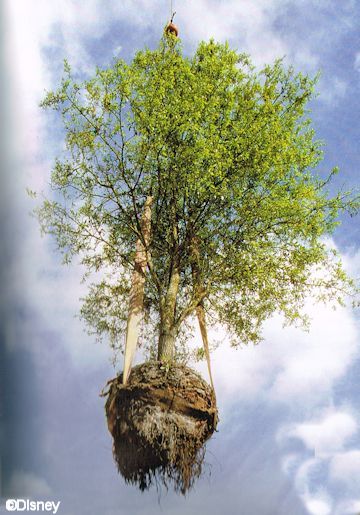
Since the Imagineers wanted the park to await fully established on opening day (April 22, 1998), the landscapers began planting the state over two years in advance. To help in the process, they imported fully grown trees from effectually the world and used accelerators in their on-property tree farm to vastly speed up a sapling's growth.
Just like at Disneyland and the Magic Kingdom, a berm was synthetic around portions of the park to hide the real world from the one they were creating for guests. And not only would these berms act as a barrier, they would as well be a place where additional plants and trees could be grown and "stored" if needed to supplant a dying species somewhere in the park at a later date.
This next movie shows the berm as seen from the parking lot. Behind this pile of dirt and dense growth lies Dinoland U.S.A. But you'd never know information technology from this angle.
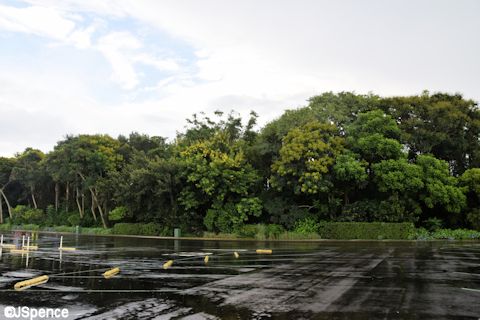
When exiting the parking lot tram, guests pass betwixt 4 planters filled with bushes and palm trees. Not only are these planters bonny, they besides serve to straight passengers away from the walkway Disney autobus guests are using. This creates a more than uniform traffic period.
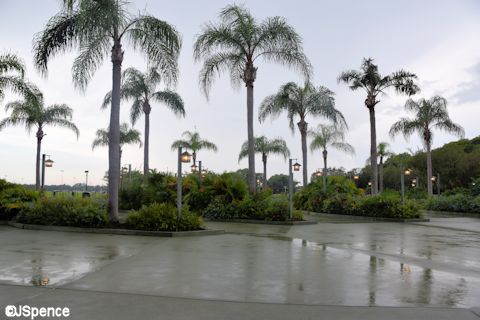

When viewed from in a higher place, the pavement coloration establish in the entrance plaza creates a big tree.

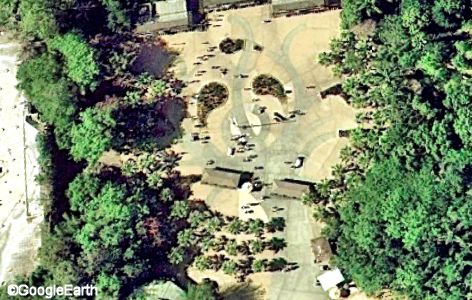
The Rain Forest Café marquee was designed not only to brandish the eatery'due south name, but at the same time human action every bit a fountain and planter. Although not obvious in this pic, water is flowing from the letters.

I've mentioned in past articles that once the Rainforest Café had vast waterfalls cascading from its roof. Unfortunately, the landscaping grew and grew until this view was completely obscured. Today, scaled backed falls have been created on the side of the building.

Near the back entrance to this eating house is a miniature rainforest complete with playful brute recreations and some giant toadstools.
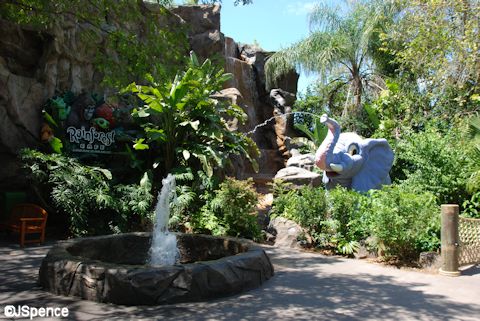
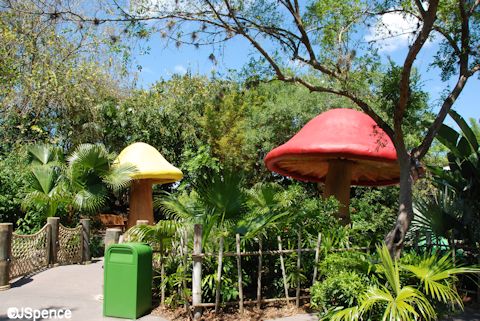
The Haven is that area located between the Animal Kingdom turnstiles and the span that spans Discovery River on the mode to Discovery Island. The Haven is equivalent to Main Street at the Magic Kingdom. It was the Imagineers intention that this area be used as a decompression spot – an expanse where guests could transition between the real world and the globe of nature and animals.
The Oasis recreates a lush tropical jungle. The only open spaces you'll observe here are the pathways that atomic number 82 guests deeper into the park. Greenery surrounds you at every plow. Yet, in that location is nothing here that stands out and grabs your attending with the exception of epiphytes.
And epiphyte is a plant that requires no soil to grow. Instead, it attaches itself to other plants but is not-parasitical. It derives its nutrients from the air, pelting, and accumulating debris near its base. If you look up into the trees and rocks of the Oasis, you lot'll encounter a number of these unique plants. (In some cases, Disney has helped the procedure forth.)


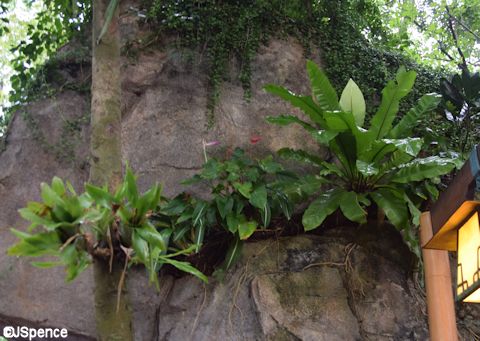

Discovery Island at the Creature Kingdom acts like The Hub at the Magic Kingdom. It ties all of the outlying lands together in a harmonious manor. But rather than depict a real geographic location, Discovery Island uses humorous, almost cartoon-similar representations of animals to create a whimsical locale that does not conflict with the other areas of the park. Ane case of this can exist seen on the clay pots that act as planters.

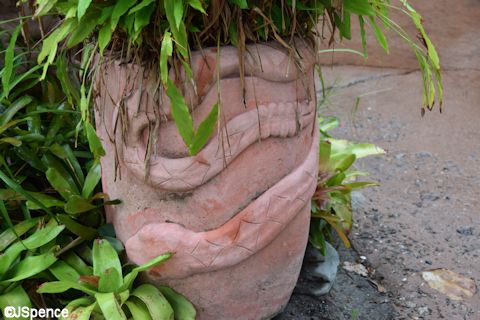

Flame Tree Barbeque offers a proficient instance of how the Imagineers don't ever get things right the get-go time around. In the first flick below, you tin see a large expanse of growth surrounding the restaurants marquee. In the 2nd picture y'all can see this has been scaled dorsum greatly to offering ameliorate pedestrian traffic flow.
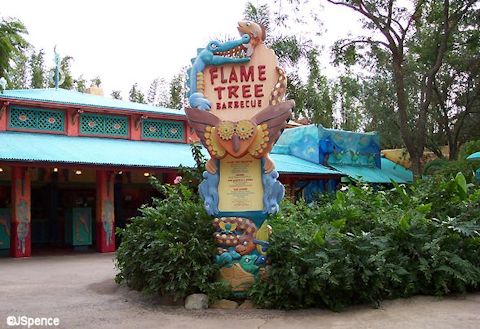
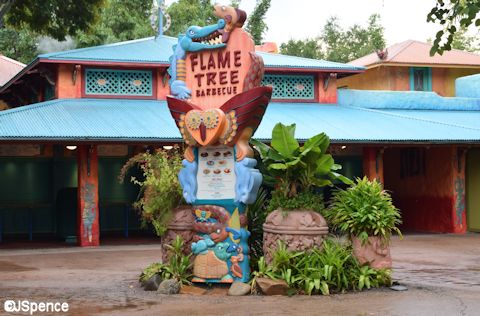
Ane of the most beautiful gardens in all of Walt Disney Earth tin can be found in the dining expanse of Flame Tree Barbeque. Here, h2o, copse, sculpture, and plants combine to create a peaceful atmosphere that has the capacity to calm the most ruffled guests.


Simply what I found interesting about this garden is that it uses several potted plants to complete the picture. If I had been designing this park-like setting, I would take made everything look as if it was naturally growing from the earth. All the same these terracotta pots fit correct in. In fact, they add together a new layer of item.
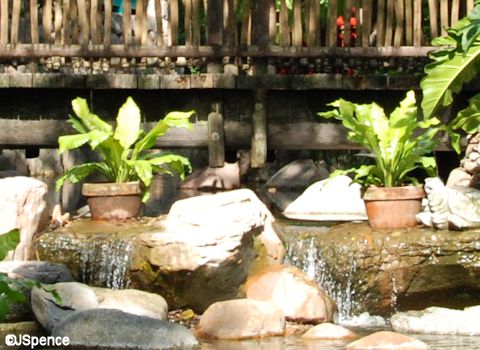
On several occasions, I have overheard immature children ask their parents if the Tree of Life is existent. In each case, the parents held back their amusement and patiently explain to their child that the tree was created by Disney. But the question does speak volumes. It shows that the Imagineers created something that looks real when viewed with emotion and without logic.
Notice in this adjacent moving-picture show how the landscapers have framed the Tree of Life with existent growth. This helps add to the illusion that this is a real tree.

Around the Tree of Life are the Discovery Island Trails. These take guests on journeys past animals and through dense growth. When walking through some of these overgrown areas, a person's imagination tin can run wild.
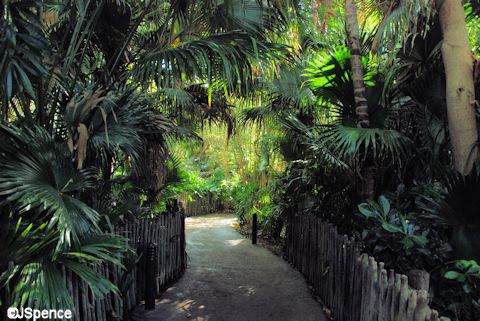
You might think that the landscaping over at Dinoland The statesA. would endeavor to recreate the humid tropics in which dinosaurs lived. But for the most part, that'south non the case. The backstory for this land tells united states that dinosaur basic were discovered near a hunting lodge that was nestled in a forest. To help with this story, a number of deciduous trees can be found around this building.
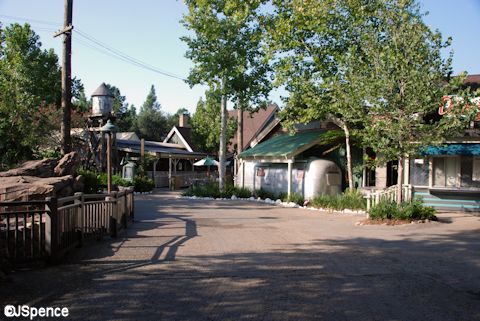
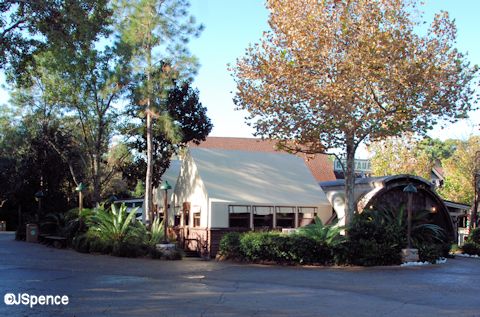
Years later when time travel was invented and the Dino Institute was established, the developers of this endeavor supplemented the adjacent woods with tropical plants. They wanted to create a earliest world that would appear suitable for dinosaurs. Then they placed recreations of these prehistoric beasts around the property to assistance promote the Establish and attract tourists.
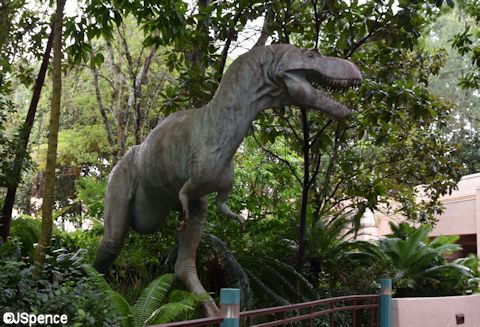

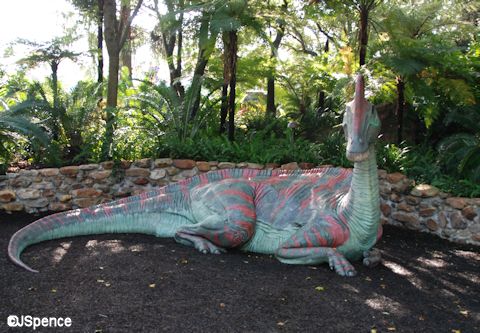

Take a look at the Dino Plant'due south entrance. Sago Palms have been placed atop the monoliths.
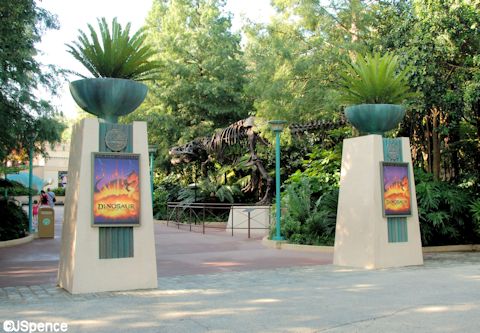

It's interesting to notation, the Sago Palm is not a palm just a cycad. Fossils of this plant have been found effectually the earth and have evolved little since the days of the dinosaurs.
Over at Chester & Hester's Dino-Rama, license plates have been used to create containers for shrubs and spell out the amusement park'due south proper name.
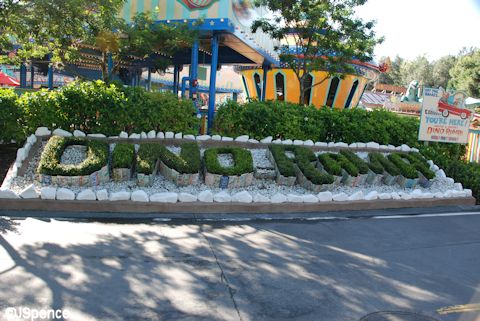
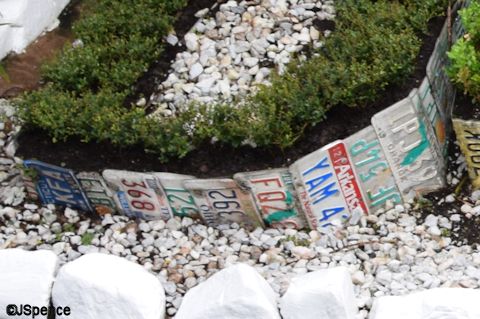
At the old gas station, an abundance of discarded tires take been put to good horticultural use.
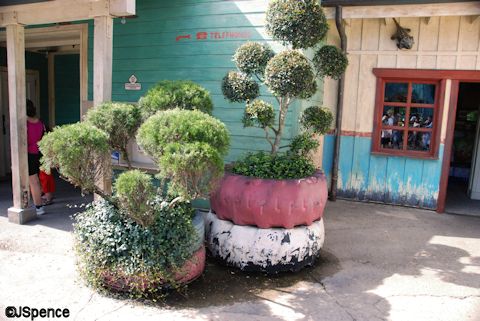

And shrubs and trees aid us believe we're really on Diggs County Road 498.


The Theater in the Wild building is large and ugly. Once again, the landscapers take used plants to aid hide this structure. In addition, they added a establish motif to the walls.


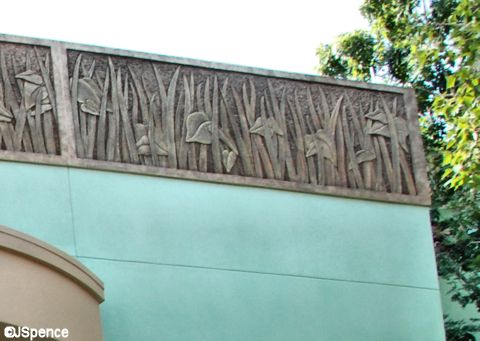
Asia represents two singled-out areas. The first of these is the wet and tropical village of Anandapur. The backstory tells of the Chakranadi (CHAWK-rah-nah-dee) River that is born from the snowmelts in the Himalayas. Its nurturing waters soon reach warmer regions where it feeds the dense jungle. Unrestrained growth is everywhere in Anandapur. What civilization there is in this area needed to exist carved out of this jungle growth. Even at present, information technology is a constant battle for the townsfolk to restrain this constant intrusion.
The starting time example of the ever-infringing jungle can be seen at this aboriginal idol. Here, a seed found a scissure in the stone and began to set downwardly roots. Then another and another. In no time at all, trees sprang forth and the structure began to crumble.
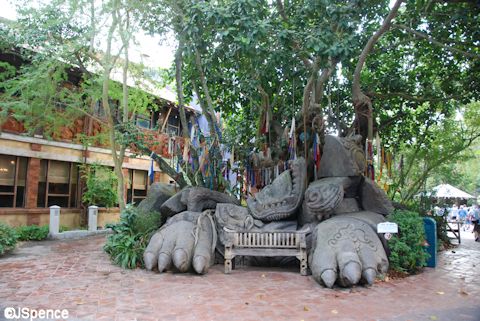
Over at the Flights of Wonder testify we see how the jungle is reclaiming this stone structure.
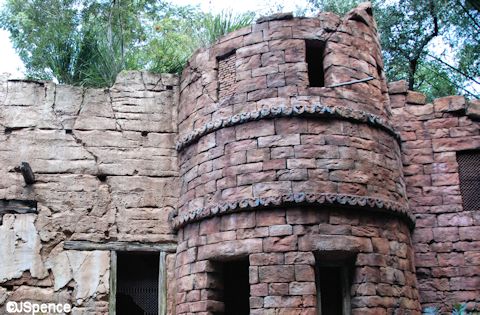
And in the floodwaters of the Chakranadi River, some other tree is wreaking havoc on a temple.

Along the Maharaja Jungle Trek, the thick growth continues. Take a look at this tree trunk located near the Komodo Dragon. It looks centuries old.

From this tree, we walk along a thickly forested walkway. It takes no imagination at all to believe you are deep in the heartland of tropical Asia. Even the rocks are beingness consumed by encroaching greenery.

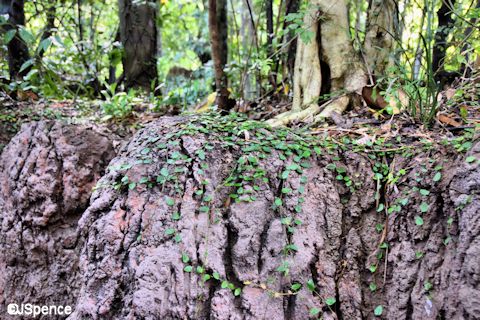
Every bit this area was in one case the individual hunting preserve of King Bhima Disampati, it was designed in a fashion conforming of royalty. This even included the landscaping. Accept a look at how these once manicured gardens take fallen into disarray. Notice how the stone borders have begun to misalign and shift over the years.

The blackbuck antelope grazes on a grassy knoll. Here, the Imagineers take tried to fob united states into assertive that this meadowland goes on forever. But in reality, only beyond the crest of this hill are barriers that proceed these animals carefully cordoned off from their nearby tiger predators.

Expedition Everest provides tours through the Himalaya Mountains. Guests wishing to explore these mighty peaks charter excursions about the base of this massive chain. In this area, the climate is much dryer than that found at Anandapur. Although trees are present, most of the plants grow low to the ground in an effort to conserve what precious water they receive each twelvemonth.
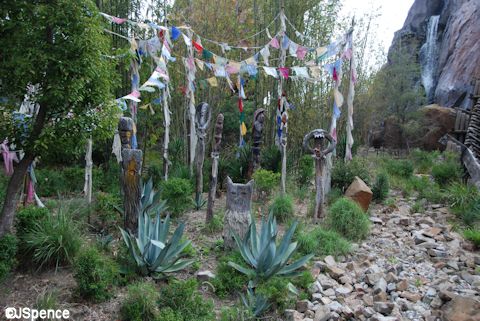
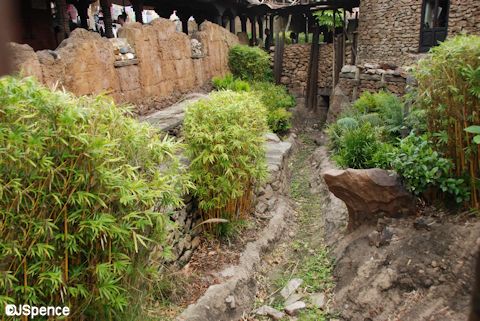

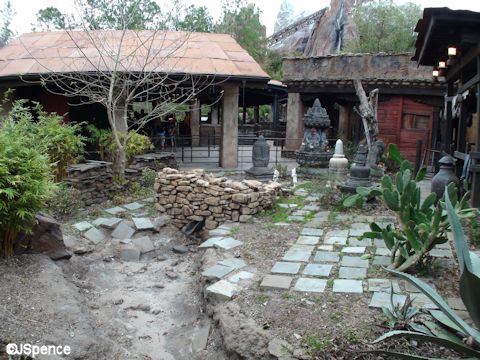
Tea is the master potable consumed by the people of Asia. So it is no wonder that it can exist seen growing in a number of areas around Trek Everest.

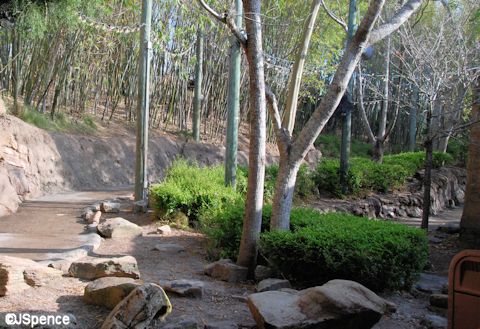
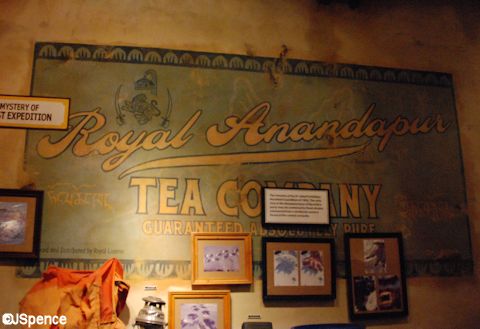
Bamboo is another institute that grows in affluence in Asia. Here at the Animal Kingdom, the landscapers plant this member of the grass family in sturdy containers. If they didn't, it would take over and abound unchecked. Find in this next pic how the bamboo is growing in clumps. This would not happen in nature.

The walkway that connects Asia with Africa traverses a lush jungle. Forth the way you only might meet Devine, the four-legged walking found.
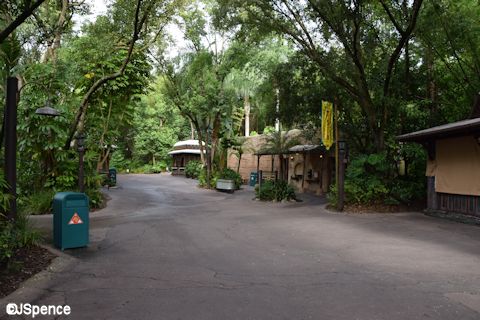

Harambe is a port town located somewhere on the east coast of Africa. For the almost part, the climate is hot with seasonal rains. Although plant life is abundant here, it isn't so thick that the town is fighting continual encroachment every bit the citizens of Anandapur must endure. If fact, the people of Harambe have used shrubs and trees in planters and gardens to assist spruce upwards their town.

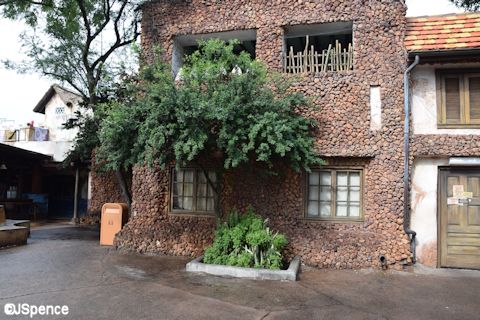
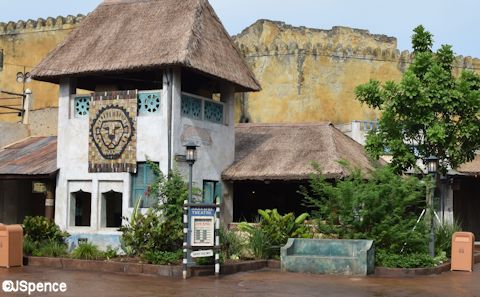
In Harambe nosotros discover a Kigelia (or sausage) tree. Today, the tree is primarily grown for ornamental purposes, but the fruit does take its uses. Although the fruit'due south liquid is poisonous, the flesh can be turned into an alcoholic beverage like to beer. The gourds are as well used by the locals to make herbal medicines that are believed to cure snakebites, syphilis, and rheumatism, among other things.
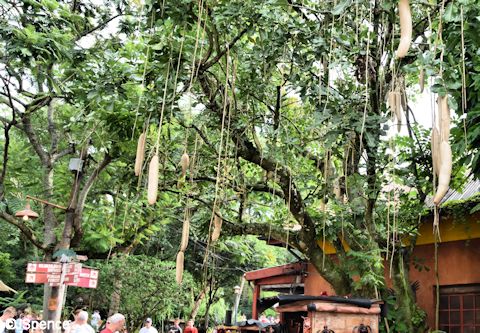

Kilimanjaro Safaris first travels through a lush jungle. Here, the plant life creates a canopy of growth that shades much of the roadway. After viewing blackness rhinos, crocodiles, bongos, and hippopotamuses, we burst out into the savanna where vast grasslands sustain wildebeests, antelope, giraffes, and ankole cattle.
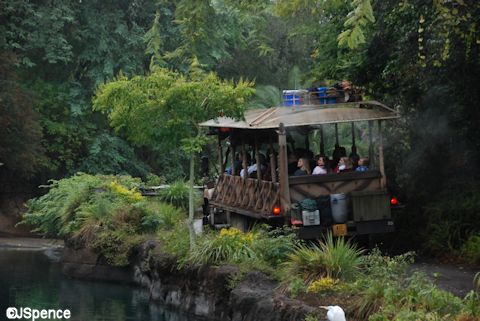
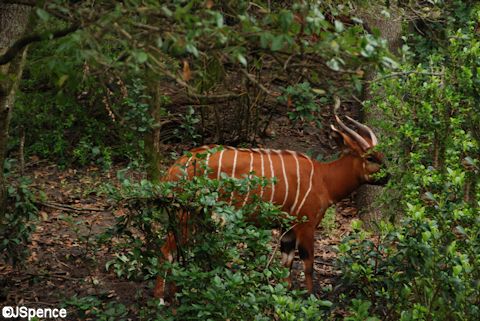

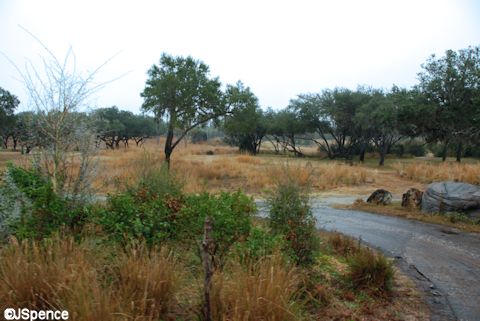
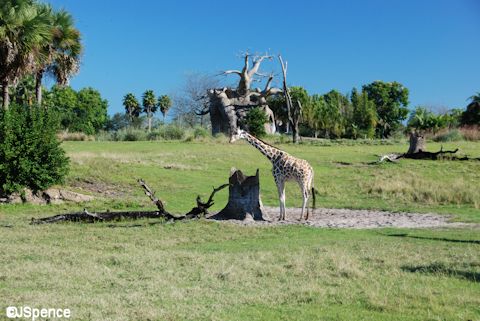

When designing Kilimanjaro Safaris, the Imagineers knew that they could never abound enough plants, trees, and bushes to sustain the animals. Yet, they wanted the area to await natural. To that end, they hid many food troughs backside simulated rocks so guests couldn't run into these feeding areas. In addition, plants in containers are deposited each night in pre-dug holes. During the day, the animals tin munch to their heart'south delight, then at nighttime, these spent plants are but picked upwardly, container and all, and replaced with a new container. This procedure is invisible to the guests and greatly simplifies the landscaper's chore.
Several baobab trees can be seen in Harambe and out on the Kilimanjaro Safaris. These trees only conduct leaves three months out of the year and the trunks incorporate vast amounts of water to sustain them during dry out periods and droughts. A baobab tree tin easily alive to be over a thousand years quondam.
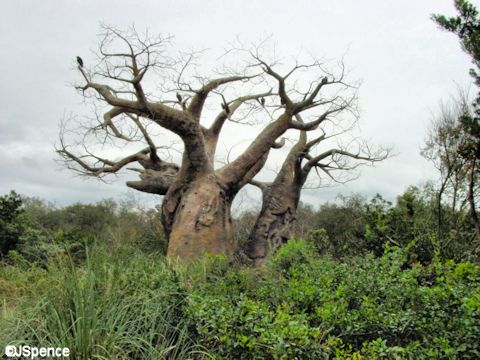

The baobab tree has many uses. The fruit contains three times the vitamin C of an orangish, fifty percent more calcium than spinach, and is loftier in antioxidants. The leaves tin be used to make a relish and a sauce or powdered to create a spice. And cooking oil can exist extracted from the seeds.
Spoiler alert adjacent ii paragraphs:
For those of you who visit often, have you ever noticed that yous never seem to call during the three months of the year when baobab copse are sprouting leaves? Well, at that place is a reason for this. None of the baobab copse you come across in the Animal Kingdom are existent. As I mentioned earlier, this species can easily alive to be over a m years old. The trees depicted in Harambe are huge and would be hundreds of years sometime if real. And since the baobab tree is not native to Florida, Disney had to create reproductions out of physical and wire. If you await closely at the upper branches, you tin see they are really rebar. Note: There a few existent sapling baobab copse in Harambe, but the large ones are fake.

Past the fashion, the termite mounds seen on Kilimanjaro Safaris are not real either. However, the ostrich eggs are authentic. They're only non going to hatch anytime soon as they have been filled with a non-organic material to give them longevity.
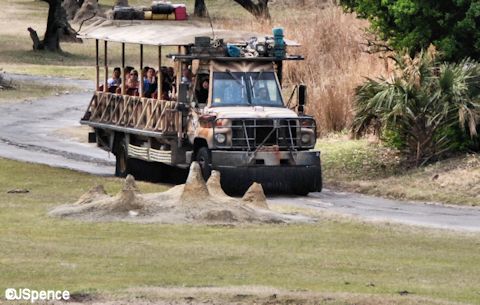

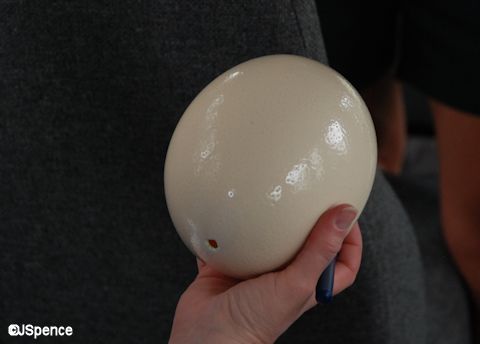
At the terminate of the safari, we are returned to the jungles of Africa where we can survey the Pangani Forest Exploration Trail. One time again, the landscaping in this part of the park is lush and verdant.
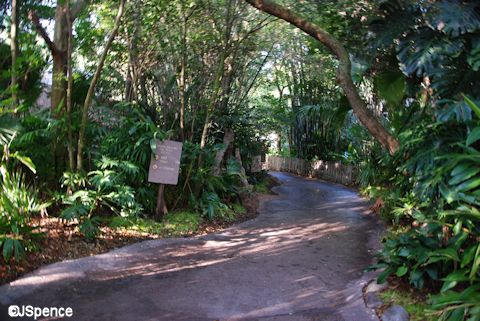
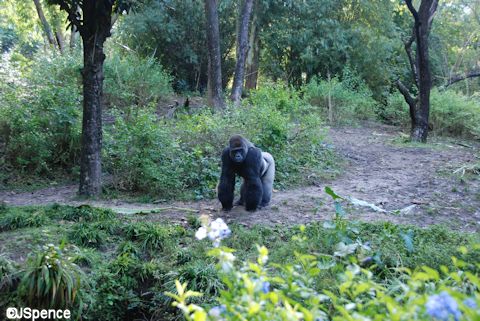

When it comes to Rafiki'due south Planet Watch, the landscaping is unremarkable. For the nigh role, it is only a continuation of the growth found at Pangani Wood. Notwithstanding, I bet most of yous didn't realize that you cross over a canal on the mode to Conservation Station. The landscaping is and so thick along the trail that it well-nigh completely hides the waterway that runs on both sides of the walkway.
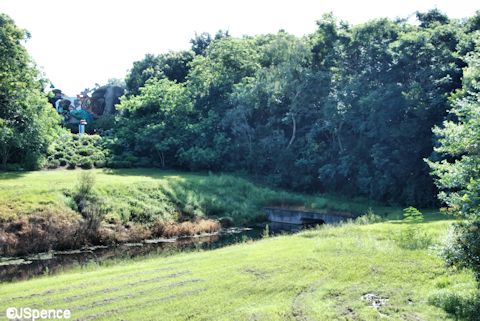
At Conservation Station, exist sure to visit the Vocal of the Rainforest allure. Here, Grandmother Willow discusses the importance rainforests play in the world'southward ecology and how vital it is to preserve them.

This concludes my look at the landscaping plant at the four Walt Disney World theme parks. I hope y'all've enjoyed this serial and have a new appreciation for the hard piece of work and serious thought that goes into every plant that is grown at Walt Disney World. Except for the rare weed, every plant was placed where it was for a purpose.
Source: https://allears.net/2014/09/15/landscaping-the-world-disneys-animal-kingdom/
Posted by: adornofreeack.blogspot.com

0 Response to "How Did Animal Kingdom Get Baboob Trees"
Post a Comment